“Get” is a common verb in English that has several different meanings and uses. In order to understand the irregular verb “get” fully, it’s important to learn about its past tense and past participle forms. In this article, we will explore both of these forms, provide examples, and link to additional resources for learning about… Continue reading GET: past tense and past participle
GET: past tense and past participle
10/10 - (1 vote)







